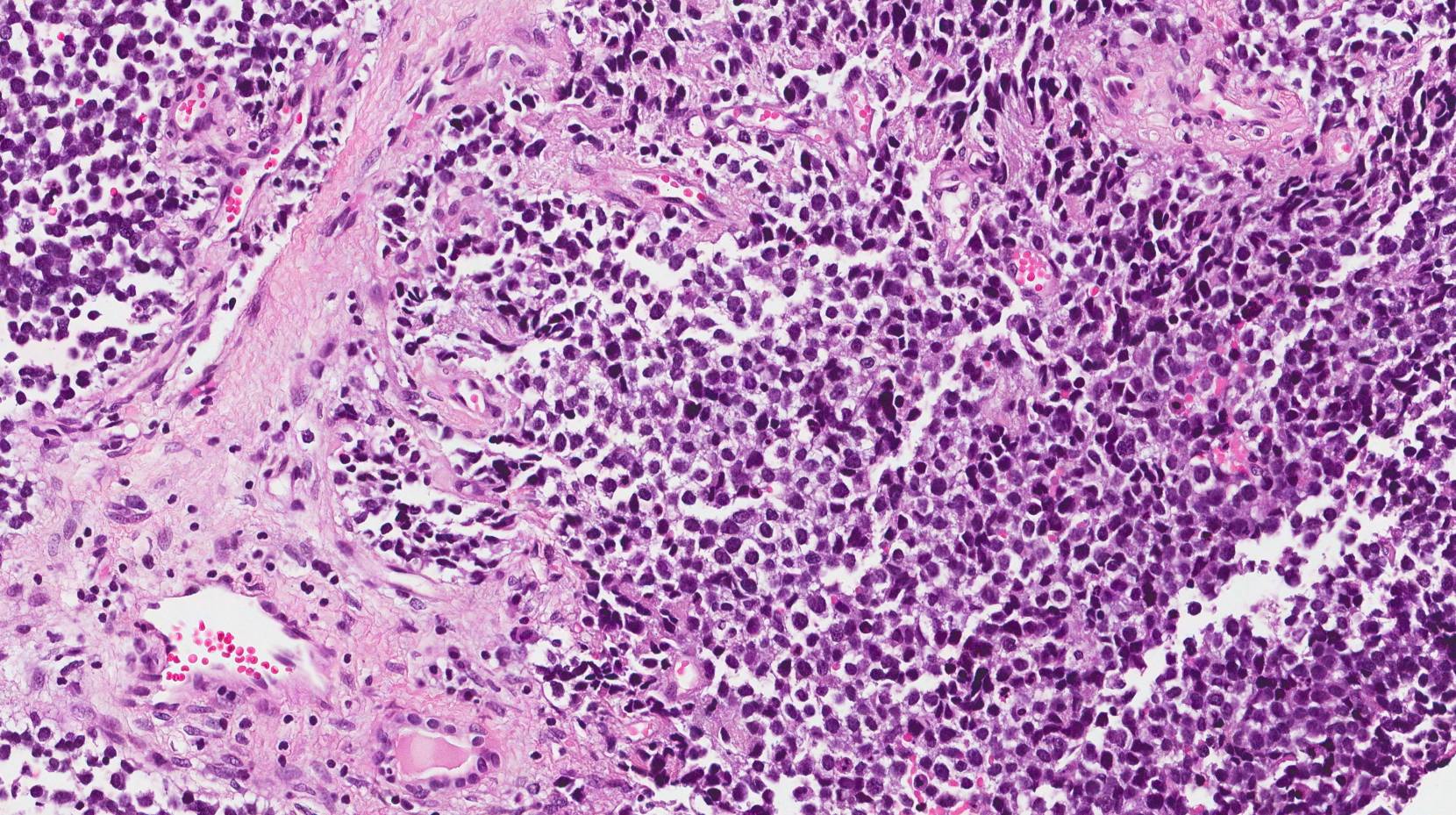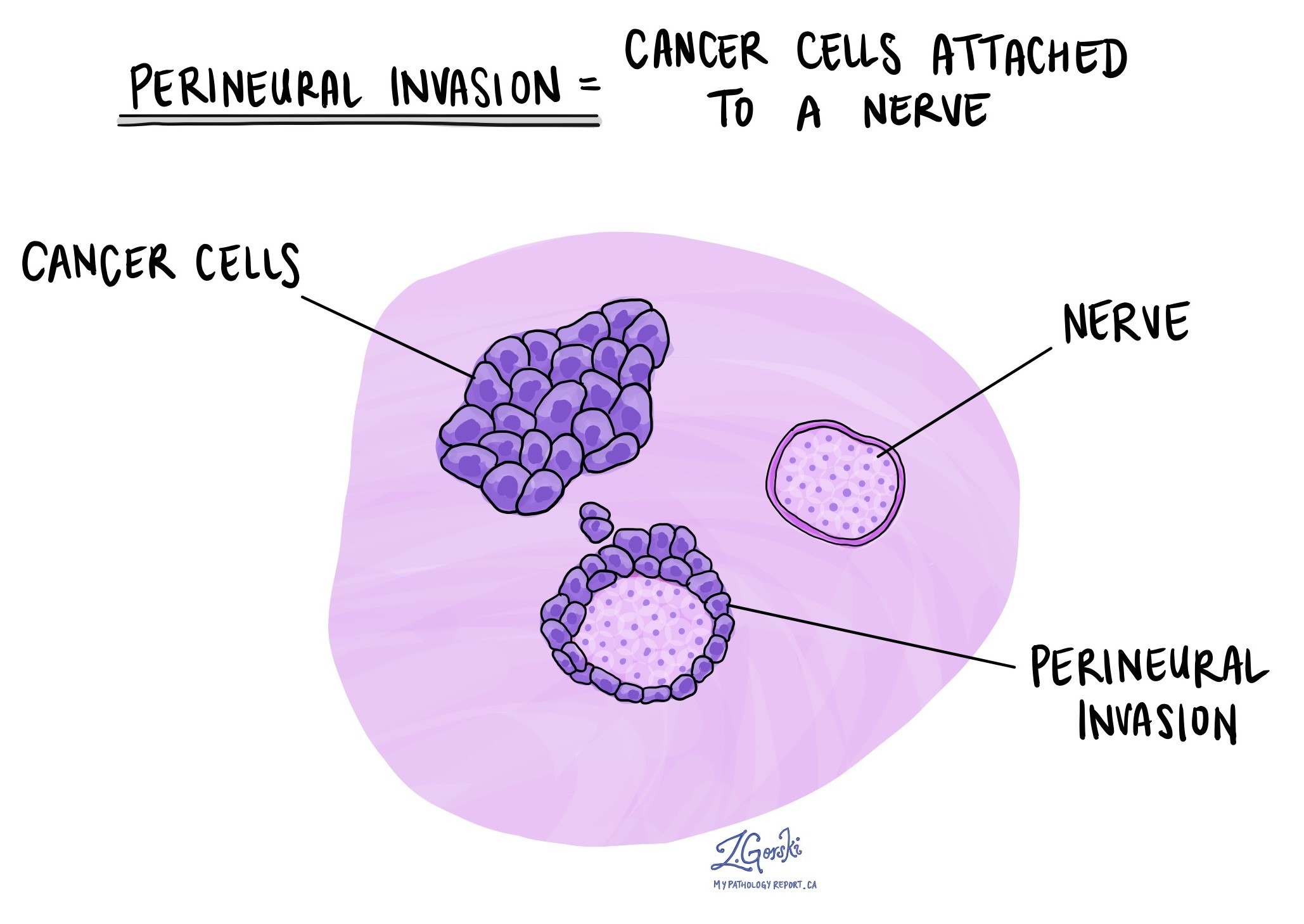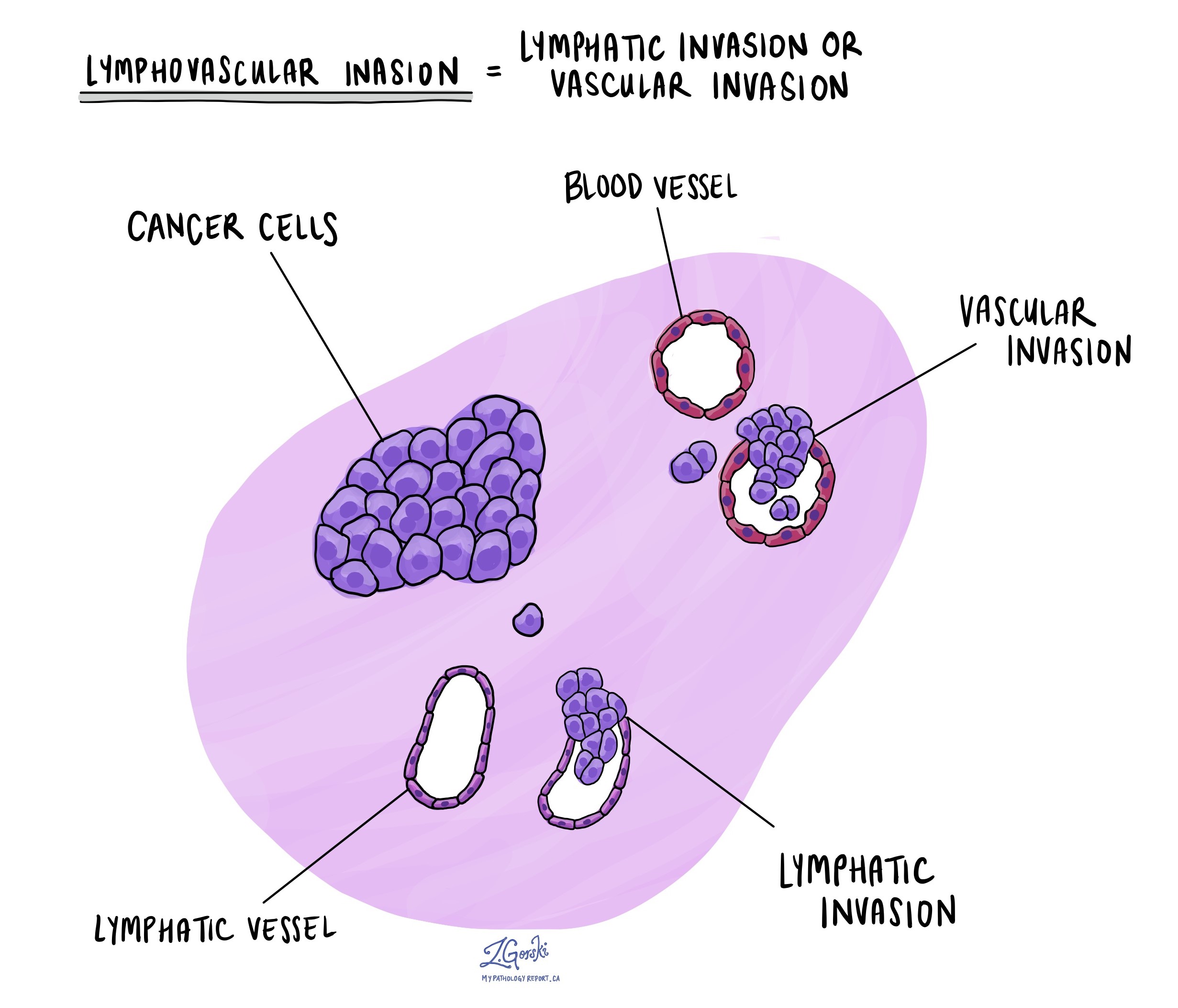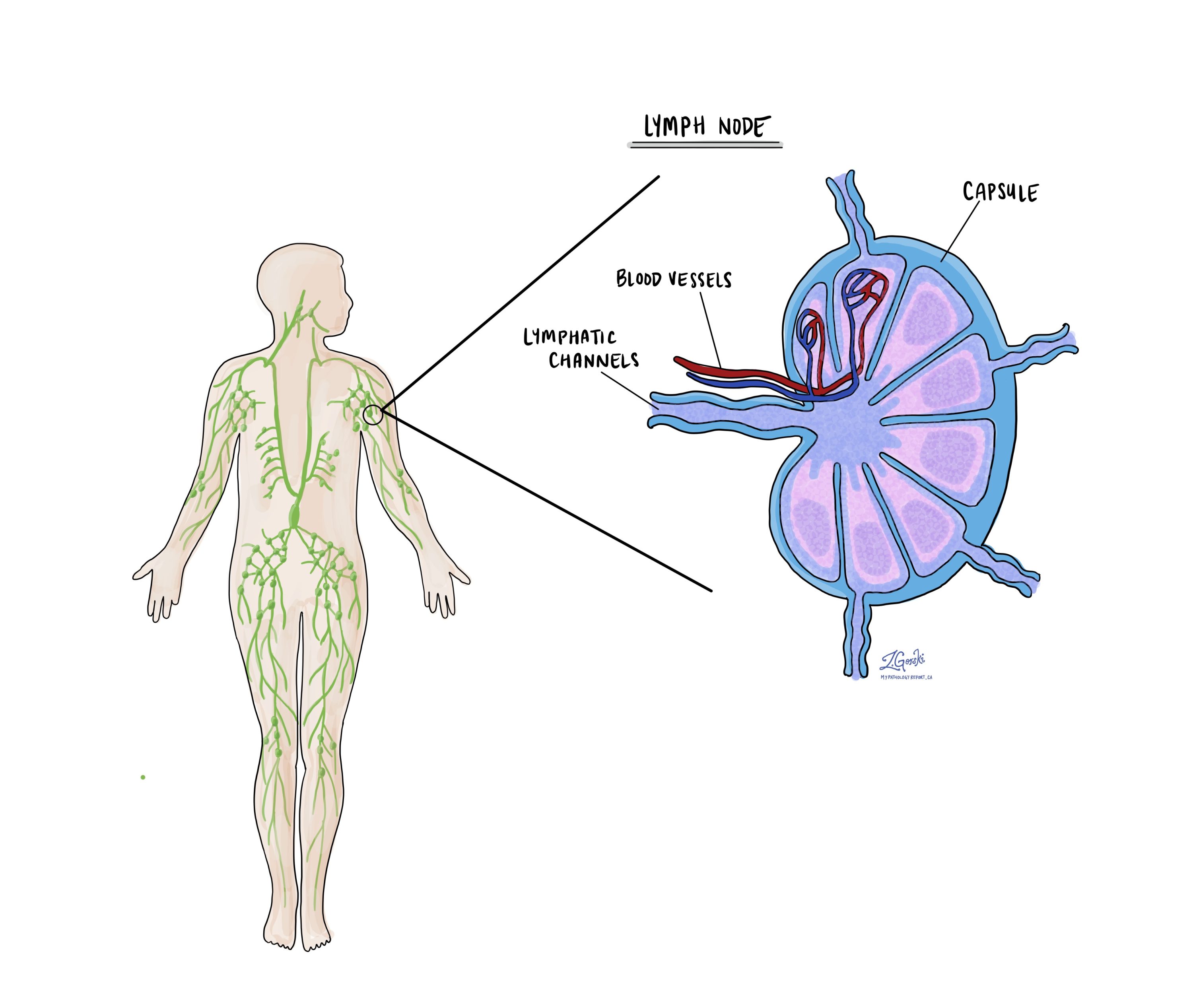by Jason Wasserman MD PhD FRCPC
December 10, 2023
Alveolar rhabdomyosarcoma is a type of cancer made up of immature muscle cells. Most alveolar rhabdomyosarcomas contain a genetic change involving the FOXO1 gene. This is an aggressive type of cancer that frequently spreads to lymph nodes and other parts of the body.
What causes alveolar rhabdomyosarcoma?
Most alveolar rhabdomyosarcomas are caused by the fusion (combination) of the gene FOXO1 with one of the genes PAX3 or PAX7. The new fusion gene leads to the production of proteins that allow the tumour cells to grow and divide. At this time, doctors do not know what causes the FOXO1-PAX3/PAX7 fusion gene to form.
Where is alveolar rhabdomyosarcoma found?
Most tumours start in the arms or legs. Other common sites include the head and neck, spine, and perineum.
What are the symptoms of alveolar rhabdomyosarcoma?
Most people do not notice any symptoms until the tumour becomes large enough to put pressure on surrounding organs and tissues. At that point, the symptoms depend on the location of the tumour. Tumours in the arms or legs may result in swelling and pain. Tumours in the head and neck may cause headaches, facial pain, nasal obstruction, nose bleeds, decreased sense of smell, or vision changes. Tumours near the spine may cause neurological symptoms such as weakness or pain in the legs while tumours in the perineum may result in difficulty urinating or constipation.
How do pathologists make the diagnosis of alveolar rhabdomyosarcoma?
The first diagnosis of alveolar rhabdomyosarcoma is usually made after a small sample of the tumour is removed in a procedure called a biopsy. The biopsy tissue is then sent to a pathologist who examines it under a microscope. After a pathologist makes a diagnosis of alveolar rhabdomyosarcoma, patients are often treated first with chemotherapy and/or radiation therapy followed by surgery. The tumour is then removed completely as a resection specimen and sent to pathology for examination.
What does alveolar rhabdomyosarcoma look like under the microscope?
When examined under the microscope, the tumour is made up of primitive appearing small round blue cells. The tumour cells are often arranged in groups called nests and the cells in the centre of the nest may appear separated. Pathologists sometimes describe this pattern as alveolar and the cells as discohesive. Mitotic figures (tumour cells that are dividing to create new tumour cells) are usually frequent.

What other tests may be performed to confirm the diagnosis?
Immunohistochemistry
Immunohistochemistry is a special test that allows pathologists to look for specific types of proteins inside cells. Pathologists use the results of this test to determine the cell’s function and where in the body the cell came from. When immunohistochemistry is performed on alveolar rhabdomyosarcoma, the tumour cells are typically positive for muscle markers such as desmin, myogenin, and MyoD1.
Molecular tests
Alveolar rhabdomyosarcoma often contains a genetic change called a translocation. This genetic change results in the FOXO1 gene combining with either the PAX3 or PAX7 gene. Pathologists test for these translocations by performing either fluorescence in situ hybridization (FISH) or next-generation sequencing (NGS) on a piece of the tissue from the tumour. If you were diagnosed with alveolar rhabdomyosarcoma, your report will say which test was performed and which translocation was found in the tumour.
Do pathologists grade alveolar rhabdomyosarcoma?
At present, pathologists do not provide a grade for alveolar rhabdomyosarcoma.
Why is the size of the tumour important for alveolar rhabdomyosarcoma?
Tumour size is important because tumours less than 5 cm are less likely to spread to other parts of the body and are associated with a better prognosis. Tumour size is also used to determine the pathologic tumour stage (pT).
What does tumour extension mean and why is it important?
Most alveolar rhabdomyosarcomas start inside of a muscle, but the tumour can grow into other organs or tissues outside of the muscle. This is called tumour extension. Your pathologist will examine samples of the surrounding organs and tissues under the microscope to look for tumour cells. Any surrounding organs or tissue that contain tumour cells will be described in your report.
What is perineural invasion and why is it important?
Perineural invasion means that tumour cells were seen attached to a nerve. Nerves are found all over the body and they are responsible for sending information (such as temperature, pressure, and pain) between your body and your brain. Perineural invasion is important because tumour cells that have become attached to a nerve can spread into surrounding tissues by growing along the nerve. This increases the risk that the tumour will regrow after treatment.

What is lymphovascular invasion and why is it important?
Lymphovascular invasion means that tumour cells were seen inside a blood vessel or lymphatic vessel. Blood vessels are long thin tubes that carry blood around the body. Lymphatic vessels are similar to small blood vessels except that they carry a fluid called lymph instead of blood. Lymphovascular invasion is important because tumour cells can use blood vessels or lymphatic vessels to spread to other parts of the body such as lymph nodes or the lungs.

What is a margin and why are margins important?
A margin is any tissue that was cut by the surgeon to remove the tumour from your body. Depending on the type of surgery you have had, the margins can include bones, muscles, blood vessels, and nerves that were cut to remove the tumour from your body. All margins will be very closely examined under the microscope by your pathologist to determine the margin status.
A margin is called negative when there are no tumour cells at the edge of the cut tissue. A margin is called positive when there are tumour cells at the edge of the cut tissue. A positive margin is associated with a higher risk that the tumour will recur in the same site after treatment (local recurrence).

What does treatment effect mean?
If you have been diagnosed with alveolar rhabdomyosarcoma on a biopsy, you may be offered chemotherapy and/or radiation therapy before the operation to remove the tumour. If you have received either of these treatments before your surgery, your pathologist will examine all the tissue sent to pathology to see how much of the tumour is still alive (viable).
There are different systems used to describe the treatment effects for alveolar rhabdomyosarcoma. Most commonly, your pathologist will describe the percentage of tumour that is dead. Pathologists use the word necrosis to describe dead (non-viable) tumours. A tumour showing 90% or more therapy response (meaning 90% of the tumour is dead and 10% or less of the tumour is still alive) is considered a good response to therapy and is associated with a better prognosis.
What are lymph nodes and why are they important?
Lymph nodes are small immune organs located throughout the body. Tumour cells can spread from the tumour to a lymph node through lymphatic channels located in and around the tumour. The movement of tumour cells from the tumour to a lymph node is called lymph node metastasis. If lymph nodes were part of the surgery to remove the tumour, your pathologist will examine them under the microscope and any lymph nodes that contain tumour cells will be described in your report.

How do pathologists determine the pathologic stage (pTNM) for alveolar rhabdomyosarcoma?
Tumours in adults are given a pathologic stage based on the TNM staging system, an internationally recognized system created by the American Joint Committee on Cancer. The TNM system uses information about the primary tumour (T), lymph nodes (N), and distant metastatic disease (M) to determine the complete pathologic stage (pTNM). Your pathologist will examine the tissue submitted and give each part a number. In general, a higher number means a more advanced disease and a worse prognosis. Tumours that start in the head and neck are not staged using this system.
Tumours in children are given a pathologic stage based on a modified TNM staging system (the Intergroup Rhabdomyosarcoma Study Group grouping system). This system uses information about the location of the tumour and the type of surgery performed in order to determine the final pathologic stage. All of this information is then combined to determine the risk of cancer coming back in the future.
Tumour stage (pT) for alveolar rhabdomyosarcoma in adults
The method for determining the tumour stage depends on the area of the body involved. For example, a 5-centimetre tumour that starts in the chest will be given a different tumour stage than a tumour that starts deep in the back of the abdomen (the retroperitoneum). However, in most body sites, the tumour stage includes the tumour size and whether the tumour has grown into surrounding body parts.
Chest, back, or stomach and the arms or legs (trunk and extremities)
- T1 – The tumour is no greater than 5 centimetres in size.
- T2 – The tumour is between 5 and 10 centimetres in size.
- T3 – The tumour is between 10 and 15 centimetres in size.
- T4 – The tumour is greater than 15 centimetres in size.
Abdomen and organs inside the chest (thoracic visceral organs)
- T1 – The tumour is only seen in one organ.
- T2 – The tumour has grown into the connective tissue that surrounds the organ from which is started.
- T3 – The tumour has grown into at least one other organ.
- T4 – Multiple tumours are found.
Retroperitoneum (the space at the very back of the abdominal cavity)
- T1 – The tumour is no greater than 5 centimetres in size.
- T2 – The tumour is between 5 and 10 centimetres in size.
- T3 – The tumour is between 10 and 15 centimetres in size.
- T4 – The tumour is greater than 15 centimetres in size.
Nodal stage (pN) for alveolar rhabdomyosarcoma in adults
Alveolar rhabdomyosarcoma is given a nodal stage of 0 or 1 based on the presence of tumour cells in a lymph node. If no tumour cells are seen in any of the lymph nodes examined, the nodal stage is N0. If tumour cells are seen in any of the lymph nodes examined, the nodal stage becomes N1.
Metastatic stage (pM) for alveolar rhabdomyosarcoma in adults
Embryonal rhabdomyosarcoma is given a metastatic stage of 0 or 1 based on the presence of tumour cells at a distant site in the body (for example the lungs). The metastatic stage can only be determined if tissue from a distant site is submitted for pathological examination. Because this tissue is rarely present, the metastatic stage cannot be determined and is listed as MX.
About this article
This article was written by doctors to help you read and understand your pathology report. Contact us if you have any questions about this article or your pathology report. Read this article for a more general introduction to the parts of a typical pathology report.


